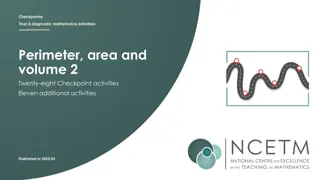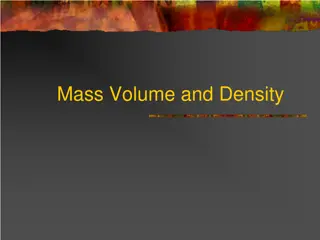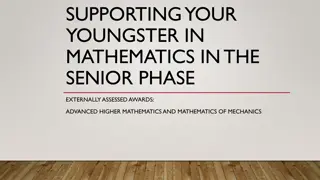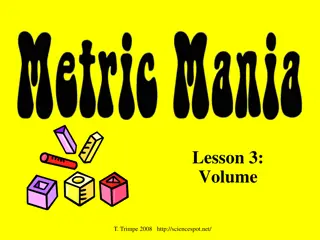Understanding Volume in Mathematics: A Comprehensive Guide for Students
This comprehensive guide delves into the topic of volume in mathematics for students. It covers the importance of volume in daily life, how to find the volume of various solid objects using formulas, solving volume-related problems, and applying volume concepts in real-life scenarios. The guide also explores practical uses of volume such as determining the capacity of aquariums, cylindrical containers, cones, spheres, and more. Through clear explanations and visual aids, students will enhance their understanding of volume calculations and their significance.
Download Presentation

Please find below an Image/Link to download the presentation.
The content on the website is provided AS IS for your information and personal use only. It may not be sold, licensed, or shared on other websites without obtaining consent from the author. Download presentation by click this link. If you encounter any issues during the download, it is possible that the publisher has removed the file from their server.
E N D
Presentation Transcript
MATHEMATICS STD-IX TOPIC: VOLUME
PDF CHAPTER LINK 1. NCERT TEXT BOOK (CHAPTER-VOLUME)
Learning Objectives Students will be able to 1. understand the importance of volume in our daily life. 2. find volume of solid objects (cuboid, cube, cylinder, cone, sphere and hemisphere)by using formula. 3. solve problem related to volume of solid objects. 4. apply the concept of volume of solid objects in day to day life.
Why will you study volume? To find capacity of aquarium. To find how much water does the cylindrical container hold? To know how much coca cola the cylindrical container hold?
Cont To find quantity of ice cream inside the cone. To know amount of air football holds. To know capacity of a hemi spherical bowl.
Introduction If an object is solid, then the space occupied by such an object is measured, and is termed the Volume of the object. On the other hand, if the object is hollow, then interior is empty, and can be filled with air, or some liquid that will take the shape of its container. In this case, the volume of the substance that can fill the interior is called the capacity of the container.
Definition of Volume The space occupied by an object is called Volume of the object. The capacity of an object is the volume of substance its interior can accommodate. The unit of measurement of either volume/capacity is cubic unit.
Volume of a Cuboid Let the area of each rectangle is A. The height up to which the rectangles are stacked is h and the volume of the cuboid is V. The area of plane regions by each rectangle height= Volume of the cuboid A h = V So ,Volume = Base area Height
Cont.. Volume of a Cuboid = base area height = ? ? Volume of cuboid =? ? ? Where , ?=length ?=breadth =height Cuboid
Volume of a cube Here length=breadth=height=? Volume of a Cube = base area height =? ? ? = ?3 Volume of cuboid =?? Where, ? = edge of the cube
Example 1 Question : A wall of length 10 m was to be built across an open ground. The height of the wall is 4 m and thickness of the wall is 24 cm. If this wall is to be built up with bricks whose dimensions are 24 cm 12 cm 8 cm, how many bricks would be required? (3 Marks)
Solution: Given : Length = 10 m = 1000 cm Thickness = 24 cm Height = 4 m = 400 cm Volume of the wall = length thickness height = 1000 24 400 ??3 1mark Now, each brick is a cuboid with length = 24 cm, breadth = 12 cm and height = 8 cm So, volume of each brick = length breadth height = 24 12 8 ??3 1mark
cont.. So, number of bricks required =?????? ?? ? ? ???? ?????? ?? ? ? ????? =100 24 400 = 4166.6 = 4167 So, the wall requires 4167 bricks. 24 12 8 1mark
Example 2 Question : A village, having a population of 4000, requires 150 litres of water per head per day. It has a tank measuring 20 m 15 m 6 m. For how many days will the water of this tank last? Solution: 1 Litre =0.001 ?3 150 Litre= 150 0.001 = 0.15 ?3 Amount of water require by 4000 people per day =4000 0.15 = 600?3 Given dimension of tank: ? = 20?,? = 15? , = 6? Volume of cuboidal tank =? ? = 20 15 6 = 1800?3 No. of days water will last =1800 600= 3 ????
Example 3 Question : A solid cube of side 12 cm is cut into eight cubes of equal volume. What will be the side of the new cube? Also, find the ratio between their surface areas. Solution: Given side of big cube =12cm Volume of big cube =123= 1728 ??3 It is cut in to 8 cubes of equal volume Let side of small cube= ? cm , So Volume of a small cube=?3 So volume of 8 small cubes= 8 ?3 According to question 8?3= 1728 ? = 6 cm Now ratio of their surface areas= 6 122 ?3= 216 6 62= 4:1
Volume of a right circular Cylinder A right circular cylinder can be built up using circles of the same size. So, Volume of right circular cylinder = base area height = area of circular base height = ??2 Volume of a Cylinder = ????
Example 4 Question :At a Ramzan Mela, a stall keeper in one of the food stalls has a large cylindrical vessel of base radius 15 cm filled up to a height of 32 cm with orange juice. The juice is filled in small cylindrical glasses (see Figure ) of radius 3 cm up to a height of 8 cm, and sold for Rs15 each. How much money does the stall keeper receive by selling the juice completely? (4 Marks)
Solution: The volume of juice in the vessel = volume of the cylindrical vessel = ??2? (where R and H are radius and height respectively of the vessel) = ? 15 15 32 ??3 1mark Similarly, the volume of juice each glass can hold = ??2 (where r and h are radius and height respectively of each glass) = ? 3 3 8 ??3 1mark
Cont So, number of glasses of juice that are sold ?????? ?? ?????? ?????? ?? ??? ????? = =? 15 15 32 Therefore, amount received by the stall keeper = Rs 15 100 = Rs1500 1mark ? 3 3 8= 100 1mark
Activity 1: Volume of a Right Circular Cone Objective : To find the volume of a right circular cone Materials required : Chart paper , sand , scissor etc. Procedure: 1. Try to make a hollow cylinder and a hollow cone like this with the same base radius and the same height. 2. Fill the cone up to the brim with sand once, and empty it into the cylinder. We find that it fills up only a part of the cylinder [see Fig. (a)]. 3. When we fill up the cone again to the brim, and empty it into the cylinder, we see that the cylinder is still not full [see Fig. (b)].
Activity 1 cont 3. When the cone is filled up for the third time, and emptied into the cylinder, it can be seen that the cylinder is also full to the brim [see Fig. (c)]. Observation: We observed that when cone is filling three times the cylinder , the cylinder is completely filled. Conclusion: So we conclude that volume of cone is one third of volume of the cylinder. See This Video for proof of Volume of cone
Cont.. Volume of cone=? Let slant height =? radius =? , height= So we can write ????? ?2= 2+ ?2
Example 5 Question :The height and the slant height of a cone are 21 cm and 28 cm respectively. Find the volume of the cone. (2 Marks) Solution : we know ?2= 2+ ?2 ? = = =7 7 cm 1mark So, volume of the cone=1 =1 ?2 2 282 212 3??2 3 22 7 7 7 7 7 21 =7546??3 1mark
Example 6 Question: The surface area of a sphere of radius 5 cm is five times the area of the curved surface of a cone of radius 4 cm. Find the height and the volume of the cone. Solution: Given radius of sphere =5cm Surface area of the sphere = 4? 5 5 ??2. Given radius of circular base of cone =4cm Curved surface area of the cone = ? 4 ? ??2 where ? is the slant height of the cone.
Cont.. According to the statement 4? 5 5 = 5 ? 4 ? or ? = 5 cm. Now ?2= 2+ ?2 2= 52 42 2= 9, ?? = 3?? So Volume of cone =1 = 50.29??3 (??????.) 3??2 =1 3 22 7 4 4 3
Volume of a Sphere Volume of a sphere of radius r =4 3??3 Volume of hemisphere of radius r = 2 3??3
Example 7 Question : Find the volume of a sphere of radius 11.2 cm (1 Mark) Solution : Given radius , ? = 11.2?? Volume of sphere =4 =4 = 5887.32 ??3 3??3 3 22 7 11.2 11.2 11.2
Example 8 Question : A hemispherical bowl has a radius of 3.5 cm. What would be the volume of water it would contain? Solution: Given radius of hemispherical bowl , ?=3.5cm The volume of water the bowl can contain =2 =2 =89.8 ??3 3??3 3 22 7 3.5 3.5 3.5
Example 9 Question : The radius of a sphere is increased by 10%. Prove that the volume will be increased by 33.1% approximately. Solution: Volume of sphere =4 10% increase in radius = 10% r ? 10=11 The volume of the sphere now becomes =4 =4 3??3 Increased radius = ? + 10? 3 11 10? 3? 3?1.331?3 ??3
Cont Increase in volume =4 =4 3?1.331?3 4 3? 0.331?3 4 3? 0.331?3 4 3??3 3??3 Percentage increase in volume = 100 = 33.1%
Summary In this chapter, you have studied the following points: 1. Volume of a cuboid = ? ? 2. Volume of a cube = ?3 3. Volume of a cylinder = ??2 4. Volume of a cone =1 5. Volume of a sphere of radius r = 4 6. Volume of a hemisphere = 2 3??2 3??3 3??3
Learning Outcomes 1. Students learn that the volume of a cuboid is ? ? . Where ?,? & are length ,breadth and height respectively. 2. Students learn that the volume of a cube is ?3. Where a is edge of the cube. 3. Students learn that the volume of a cylinder is ??2 where r is the radius of the base and h the height of the cylinder. 4. The volume of a cone is one-third the volume of the cylinder of the same height (h) and radius of base (r), i.e. equal to = concrete activity and the ratio involved, students are likely to remember the result of the activity easily. 1 3??2 .Because of the simplicity of the
Cont 5. The students arrive at the formula for the volume of a cone through a simple activity, which relates it to the volume of a cylinder. 6. Students learn that the volume of a sphere & hemisphere. 7. Students learn that how to use the volume of these solid objects in daily life situations.























